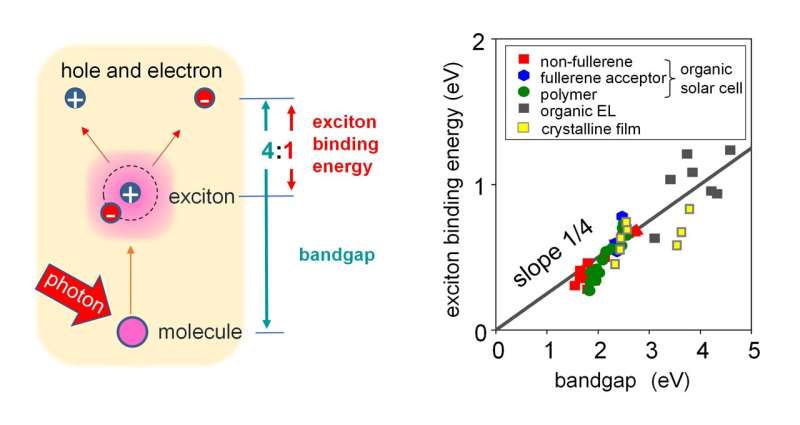This article has been reviewed according to Science X's editorial process and policies. Editors have highlighted the following attributes while ensuring the content's credibility:
fact-checked
peer-reviewed publication
trusted source
proofread
Research reveals new insights into exciton binding energies in organic semiconductors

Organic semiconductors are a class of materials that find applications in various electronic devices owing to their unique properties. One attribute that influences the optoelectronic property of these organic semiconductors is their "exciton binding energy," which is the energy needed to divide an exciton into its negative and positive constituents.
Since high binding energies can have a significant impact on the functioning of optoelectronic devices, low binding energies are desirable. This can help in reducing energy losses in devices like organic solar cells.
While several methods for designing organic materials with low binding energies have been investigated, accurately measuring these energies remains a challenge, primarily due to the lack of suitable energy measurement techniques.
Advancing research in this domain, a team of researchers led by Professor Hiroyuki Yoshida from the Graduate School of Engineering at Chiba University, Japan, have now shed light on the exciton binding energies of organic semiconductors.
Their study was published online in The Journal of Physical Chemistry Letters. Ms. Ai Sugie from the Graduate School of Engineering at Chiba University, Dr. Kyohei Nakano and Dr. Keisuke Tajima from the Center for Emergent Matter Science at RIKEN, and Prof. Itaru Osaka from the Department of Applied Chemistry at Hiroshima University were involved with Prof. Yoshida in undertaking this study.
Prof. Yoshida says, "In this study, a previously unpredicted nature of exciton binding energies in organic semiconductors was revealed. Given the fundamental nature of our research, we expect long-term and persistent effects, both visible and invisible, on real-life applications."
The team first experimentally measured the exciton binding energies for 42 organic semiconductors including 32 solar cell materials, seven organic light-emitting diode materials, and three crystalline compounds of pentacene.
To compute the exciton binding energies, the researchers calculated the energy difference between the bound exciton and its "free carrier" state. While the former is given by the "optical gap," linked to light absorption and emission, the latter is given by the "transport gap," which denotes the energy needed to move an electron from the highest bound energy level to the lowest free energy level.
Experimental determination of the optical gap involved photoluminescence and photoabsorption experiments. Meanwhile, the transport gap was computed through ultraviolet photoelectron spectroscopy and low-energy inverse photoelectron spectroscopy, a technique pioneered by the research group.
The use of this framework enabled the research team to determine exciton binding energies with a high precision of 0.1 electron volts (eV). The researchers believe that this precision level can help discuss the exciton nature of organic semiconductors with much higher confidence than previous studies.
Moreover, the researchers observed an unexpected aspect of the nature of exciton binding energies. They found that the exciton binding energy is one-quarter of the transport bandgap, irrespective of the materials involved.
The outcomes of this study are set to shape the fundamental principles pertaining to organic optoelectronics and also have potential real-life applications. For instance, the design principles regulating organic optoelectronic devices are expected to change favorably.
Moreover, given the potential of these findings to influence concepts within the field, the researchers believe that these findings are also likely to be included in future textbooks.
Prof. Yoshida concluded, "Our study contributes to advancing the current understanding of the mechanism of excitons in organic semiconductors. Moreover, these concepts are not only limited to organic semiconductors but can also be applied to a wide range of molecular-based materials, such as bio-related materials."
More information: Ai Sugie et al, Dependence of Exciton Binding Energy on Bandgap of Organic Semiconductors, The Journal of Physical Chemistry Letters (2023). DOI: 10.1021/acs.jpclett.3c02863
Journal information: Journal of Physical Chemistry Letters
Provided by Chiba University





















